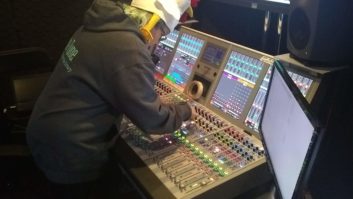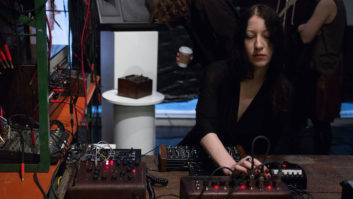The most dangerous man in the music business is on his third, or maybe his fourth, company. He’s been selling audio software on the Internet since he was a sophomore in high school, and his latest product looks like it’s going to make at least one of his partners a functional millionaire. It’s a little 2-megabyte Macintosh program that neatly circumvents any copy-protection scheme on any audio program, file or stream and lets you make a digital copy of it. It costs all of $16.
Last month, the most dangerous man in the music business turned 20. And he works for me.
Say what? Okay, I’ll back up a little. First of all, he’s not really the most dangerous man in the music business, although since Napster collapsed, that title has certainly been up for grabs. But he and two youthful cohorts — hackers, in the original, positive sense of the term, who, by the way, have never actually all met in person — are working on stuff that the record industry really, really hates. And if nothing else forces the dinosaurs of the RIAA into the new millennium, their product will do the trick.
It has an admittedly provocative name: Audio Hijack. Running under Macintosh OS X, Audio Hijack takes advantage of Apple’s flexible sound architecture, Core Audio (which I wrote about last month), to intercept — at the digital level — any audio signal that passes through the Mac, process it and store it as a high-resolution .AIFF file. It’s like the old QuickTime Audio Extraction function on steroids; instead of just working with audio CDs, it can also handle Internet streams, DVDs, MiniDiscs and external MP3 players. Whatever “protection” anyone tries to build into an audio file, Audio Hijack simply sidesteps it; if you can play it through the Mac speaker, Audio Hijack can record it.
So, where is this guy? Somewhere in a cellar in Eastern Europe, in one of the copyright-averse areas of the Far East, on a well-defended mountaintop in Idaho or sunning in a tiny Caribbean tax haven? No, he lives about a mile from me, in a dorm room at the college where I teach. He’s a second-year undergraduate majoring in computer engineering. And he happens to be the systems administrator and chief technician in my music and multimedia laboratory.
His name is Paul Kafasis, and he comes from New Jersey — “Exit 8A,” he told me when we met last year, before I could even ask. (And if you don’t understand that reference, then you need to spend more time on the East Coast.) Although he loves music and played the drums for a while in grade school, he doesn’t think of himself as a musician. His tastes are eclectic: When I walk in on him working in my lab, he might be listening on his laptop to Soul Coughing, Eminem or acoustic blues.
Unlike many of his contemporaries, he’s well-aware that there was a world before there was a Web. During the last semester break, he read Tom Wolfe’s The Electric Kool-Aid Acid Test, and he wrote in his “blog” that he is intrigued by Neal Cassady’s constant striving (through drugs, unfortunately) to overcome the 1/30th-second delay between reality and humans’ perceptions of it.
He’s a big help in the lab, and I’m seriously considering asking some of my colleagues to flunk him so that I can keep him around another year or two. I have to admit, he reminds me of myself a couple decades ago, in that he’s willing to put insane amounts of time to keep up with the latest programs, prices, utilities and system patches. And, he’s pretty enthusiastic about all of it. (Remember when we all felt that way?)
He did mention to me some time ago that he was working on music applications, but I didn’t realize how serious he was until after I spoke with Dan Brown at Apple — the conversation I reported on last month. At Dan’s urging, I visited the “osxaudio.com” site, and there on the front page was an interview with my lab tech. So I did some hunting around the Net for more on the lad (I discovered that he graduated from one of the top high schools in New Jersey, with near-perfect SAT scores), and then sat him down and grilled him about his company and his product.
Paul was 16 when he first got involved with music software. He wrote a review for a Web magazine on StripAmp, a control-strip module for MacAmp, then the leading Macintosh MP3 player. StripAmp was written by Alex Lagutin, then a 25-year-old engineer who was indeed behind the former Iron Curtain; in Siberia, in fact. It was freeware, but Paul thought people would pay for it. Being in Russia, however, Alex couldn’t set up an account that would accept credit card payments, so Paul convinced Alex (“I told him I was a college student, since I didn’t think he’d take me seriously if he knew my real age.”) to let him create a paper company, called “PK Industries,” register it with e-commerce provider kagi.com and start taking orders at $5 a pop. Users could download a time-limited version of the program for free, and when they decided that they wanted the full version, they’d send a payment to Paul and then Alex would e-mail them a registration code. Every few weeks, Paul would arrange to wire-transfer the funds to Alex.
The team took in a couple thousand dollars, and their work caught the attention of @soft Software, the Swedish company that distributed MacAmp. They both went to work for the company: Alex writing an equalizer plug-in for the program, and Paul taking care of “anything a native English speaker would do,” like documentation, Web content and PR. After @soft dissolved, Paul and Alex formed a new company, Subband Software, joining forces with the original creator of MacAmp, Dmitry Boldyrev, and a student at the University of Maryland named Quentin Carnicelli. “Alex had the idea to record an .AIFF file from another application within MacAmp,” says Paul, and he wrote a plug-in that could do that. This was the first incarnation of Audio Hijack.
“MacAmp has its own DSP architecture,” explains Paul, “which allows incoming audio to be filtered, processed, played on the speaker and/or captured to disc. People mostly used our plug-in to capture streaming RealAudio files,” which normally can’t be recorded except as an analog signal from the Mac’s output, “and to enhance playback of the audio on DVDs, adding EQ, reverb or whatever. And it can also be used to rip audio from DVDs by intercepting the output from DVD Player,” the free application that Apple supplies with each new Mac. “There are underground DVD rippers out there. They have to find the audio on the disc, recognize the codec and do the conversion to MP3 or .AIFF. This is much easier, since you just use it with software that you have.”
But MacAmp was soon made obsolete by another free piece of Apple software, iTunes. iTunes, however, doesn’t have the earlier program’s DSP plug-in capabilities. Paul, Alex and Quentin realized that under OS X, Audio Hijack could be spun off as a stand-alone application, which could then accept plug-ins itself. So last fall, they formed yet another company. Around the same time, Alex moved a little closer to his partners — to St. Petersburg — but he has still never set foot outside of Russia.
“We didn’t want to be known as an MP3 company, and didn’t want to be judged by our old companies,” says Paul. Rogue Amoeba (www.rogueamoeba.com) was the name they came up with for the company after some three weeks of deliberations. “No, there’s no significance to it,” he says.
How does Audio Hijack work? It’s actually quite simple. First, you launch it and then the application you want to rip from. “It presents a spoof of Core Audio to the application you’re using so that the audio is passed to Hijack,” says Paul. In other words, it fakes out the operating system into thinking that the audio is going to someplace normal, like the Mac’s audio-output circuit, when actually it’s being sucked up by the Audio Hijack “shell,” which can process it in dozens of ways and store it on disc as an .AIFF file. It’s then passed back to the real Core Audio so that you can hear what you’re doing.
You can open multiple instantiations of Audio Hijack, which means that you can record several different streams at the same time: a DVD movie, an audio CD, an MP3 file from an iPod, music and effects from a game, and a streaming RealAudio file. “We’re looking at how to combine multiple streams into a single pipe,” says Paul. “A ‘total jack.’ We don’t have the interface for it yet, but if we get a lot of requests, we’ll add it.”
Several DSP functions, written by Alex, are built into the software, like reverb, EQ, VU meters and an oscilloscope. Although the people at Waves don’t have anything to worry about, the modules are respectable. More importantly, however, the current version of the software — 1.6.5 — includes “VST Hub,” a wrapper for VST plug-ins from any source.
Another feature is a timer that works just like a VCR but for Webcast audio. “If you’re interested in hearing streams from around the world, like the BBC, they often come at inconvenient times,” says Paul. “With the timer, you save a ‘config’ file that contains the input you want, the time, the destination and any DSP you want to add. You can target it at a URL, a bookmark or a ‘.rm’ [RealAudio] file. At the right time, it opens the appropriate application, loads the stream and records it.”
Version 2.0, which may be out by the time you read this, will be able to rip audio from running applications, so you can launch Audio Hijack and other programs in any order you like. Although it is OS X-only (no Classic mode!), it can host many “noncarbonized” (that is, they haven’t been updated for OS X) VST plug-ins. It will also support OS X’s Audio Units, which will make it compatible with even more third-party plug-ins, as well as external audio cards and interfaces. “People have also asked for live input,” says Paul, “and we’re working on that.”
They’re also working on writing files at different sample rates, word lengths and formats — most notably, MP3s. Their MP3 encoder is based on the open-source LAME, which, in true open-source tradition, stands for “LAME Ain’t an MP3 Encoder.” But because Audio Hijack is a commercial product, the company will still have to pay Fraunhofer IIS, who holds the patent on MP3, $2.50 per unit, which raises the retail price a bit.
Paul, who lists his company title as “CEO/lackey,” is still handling the finances for the company and designs a lot of the user interface using Apple’s Interface Builder for OS X. Quentin builds the working front end, while Alex toils away on the back-end code. They split the revenue more or less equally. “We’re projecting revenues in mid-six-figures for the fiscal year,” says Paul. Do the arithmetic, and you’ve got a couple of young men who are doing a nice job of putting themselves through two top colleges, and a guy in Russia who is making — relative to that country’s per-capita gross domestic product — the equivalent of about $20,000 a week.
And how about video? Is there a “Video Hijack” in Rogue Amoeba’s future? “That’s the single question we get most often,” Paul says. “But it’s completely different technology, and we’re not planning to go there at all.”
Naturally, considering the audience it’s aimed at, a number of potential users will try to obtain Audio Hijack without paying for it. “We’ve had very good response from users and reviewers, and a lot of people have told us, ‘I gotta have this,’ and have tried to hack it,” says Paul. “On the serial-number pirating sites, they love us. And there was a valid serial number being passed around for a while, but we found out about it and blocked it. Maybe 100 people all told will figure out how to pirate it, but the rest will pay for it. I mean, it’s only $16!”
Apple’s Dan Brown, as I reported last month, considers Audio Hijack to be a shining example of how OS X’s music and audio architecture lends itself to creative third-party development. But other companies — and their favorite legislators — may not be so sanguine. Under the various radical changes in copyright law that have been proposed in — and sometimes passed through — Congress in recent years, merely possessing a copy of Audio Hijack could be considered a felony.
“We realize that some people may believe that this is violating some laws currently in existence,” says Paul. “However, in terms of fair use, Audio Hijack really is in the clear. Time shifting was ruled legal by the Supreme Court in 1984. The idea was, ‘Hey, you can watch this show at home, why shouldn’t you be able to watch it on your own time?’ We believe the same idea clearly applies to digital content. Why shouldn’t you be able to record a Real stream that comes in the middle of the night, burn it to a CD and listen to it on the way to work?
“Likewise, if you’re allowed to have a Windows Media file on your local machine and play it whenever you like, why shouldn’t you be able to convert that to MP3 and play it on your iPod? The RIAA fought the original Rio MP3 players, but the court ruled that they were legal. Audio Hijack simply aids this digital ‘space shifting’ by removing limitations set by file formats.
“However, these laws have not been well-applied to digital content, and the DMCA [Digital Millennium Copyright Act] and other restrictive laws are making it more confusing. We’re hoping, if it ever comes to this, that the courts will agree with us on both of these points.”
And they have allies besides Apple. A small Missouri company called 321 Studios last spring sued nine major film studios in a pre-emptive move to have its $100 software “DVD Copy Plus” declared legal and parts of the DMCA declared unconstitutional. The designers are not stupid: They designed the software so that (just like the RIAA-backed SCMS that so efficiently killed the domestic DAT market) a copied DVD can’t be copied, which means that real pirates won’t find it very useful.
The suit was filed in a San Francisco federal court — “a more friendly jurisdiction,” according to Paul. “Hopefully, the case will force a fair-use provision into the DMCA and that will help us.” The boys from Rogue Amoeba are not the only ones who are watching this very carefully. If the suit is successful, the media conglomerates will no longer be able to scream “piracy” at the appearance of every new format and tool. They may just have to come up with better reasons for people to buy their products than merely because they’ve put a permanent legal hammerlock on intellectual property. And they’ll have to find better ways — more flexible and appropriate for a thriving, truly open market — to sell them, too. Imagine that.
Paul Lehrman would feel much safer in a world where more drivers were listening to last night’s Webcast and fewer were yakking on their cell phones.





